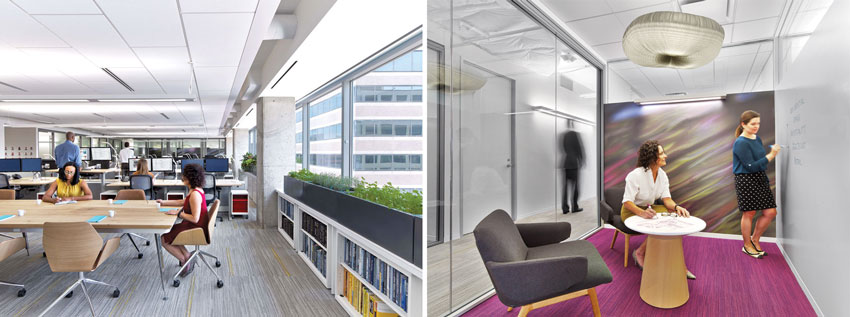Wellness in the Workplace
WELL is organized around seven “concepts,” or categories: air, water, nourishment, light, fitness, comfort, and mind. Under each of these headings are 100 “features” or strategies for creation of a healthful environment. Some features, such as controlling glare from daylight and electric illumination, clearly fall under the purview of the design team; others, such as business travel policies intended to minimize disruptions to employees’ sleep and fitness regimens, are the responsibility of the client. The standard’s features include preconditions that must be satisfied for a project to earn a Silver rating, the most basic level of certification. “Optimizations” are optional features that project teams can pursue to achieve Gold or Platinum.
Similarly, Fitwel comprises 63 strategies affecting at least one of seven “health impact categories”: healthy food options, physical activity, sense of well-being, morbidity and absenteeism, community health, social equality for vulnerable populations, and occupant safety. The strategies, derived from a five-year survey of more than 3,000 peer-reviewed research studies, are allocated points according to a CDC-developed algorithm that accounts both for the strength of the research linking each measure to health outcomes and for the strength of the measure’s impact. For instance, out of a possible total of 144 points, projects can earn up 30 points for measures that encourage healthy eating and beverage consumption and up to 16.33 for a prominent, well-designed stair. As the research base grows, the standard will evolve in response to the CDC’s continuing input.

PHOTOGRAPHY: © ERIC LAIGNEL
DOUBLE PLATINUM
The daylight- and plant-filled Washington, D.C., headquarters of the American Society of Interior Designers includes a variety of work environments, including open work stations, a community table (left), and huddle rooms (right). The offices, designed by Perkins+Will, earned Platinum certification for both LEED and WELL.
Those familiar with the two standards generally agree that achieving WELL certification is more difficult than Fitwel, especially if not considered from a project’s early stages. But they say WELL is not a huge stretch for organizations with sustainability ingrained in their culture. COOKFOX Architects recently achieved WELL Gold for its new offices in Midtown Manhattan, which have three terraces with vegetable and wild flower gardens and an apiary. Among the firm’s past projects is the New York skyscraper One Bryant Park, completed in 2009—the first LEED Platinum commercial high-rise. “WELL is consistent with our body of work,” says Zach Craun, a COOKFOX associate. Craun says that, without any modifications to its base concept for the new offices (which he describes as “LEED Platinum with biophilia incorporated”), the project would have qualified for WELL Silver. But by making mostly operational modifications, such as changes to the firm’s business travel policy and the inclusion of a bike-repair station (on top of bike storage and shower facilities already part of its LEED filing), the project earned the higher WELL rating.
Architects and designers say that, by and large, WELL and LEED are complementary, though it can be tricky to square some of the wellness standard’s lighting features with LEED’s energy credits. Ken Wilson, a principal at Perkins+Will and the lead designer on the recently completed offices for the American Society of Interior Designers (ASID) in Washington, D.C., points to WELL’s added air-filtration requirements. If ASID had not pursued WELL, it might have been able to earn one or two more energy points, he says. “But it didn’t hold us back.” The offices earned Platinum ratings for both WELL and LEED.
Davis Partnership Architects had a similar experience with a new three-story headquarters building it designed for the Colorado Health Foundation in the Uptown neighborhood of Denver. Principal David Daniel says it was tricky to find a balance between lighting levels and glare control while at the same time keeping the amount of glazing low in order to mitigate heat gain and loss. He expects the project, completed in 2016, to achieve Gold for both WELL and LEED.
One of the major factors in Fitwel’s ease of use is its suitability for existing workspaces. (This was a priority for the public agencies and the nonprofit organization behind the rating system.) With only about 2 percent of commercial floor space newly constructed each year, existing buildings represent the primary opportunity for improving health impacts in the workplace. Fitwel has no mandatory credits that could preclude existing buildings from seeking certification; a team may choose the suite of strategies most relevant to a project’s circumstances.
Boston-based CBT Architects’ renovation of Shawmut Design + Construction’s 75,000-square-foot headquarters in a historic brick and heavy-timber building, completed in 2016, provides an example. Although CBT and the client had prioritized health from the outset, prerequisites that are hard or impossible to satisfy after the fact (such as the precon-ditions in WELL for integrative design and construction-pollution management) would most probably have precluded certification. Under Fitwel, however, the project’s high Walk Score (a rating based on amenities within walking distance), new pedestrian-oriented entrance, prominent stairs, generous daylighting and views, attention to indoor air quality, and variety of shared spaces—among other credits—easily lift the project over Fitwel’s 90-point minimum for single-star certification.









